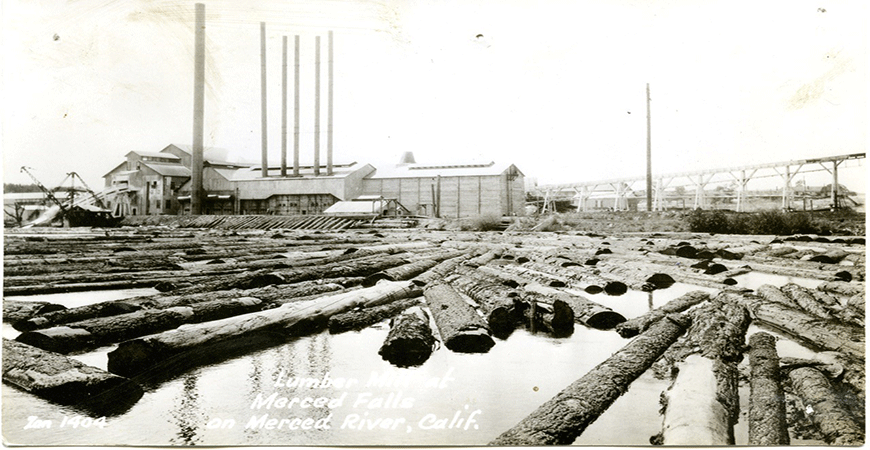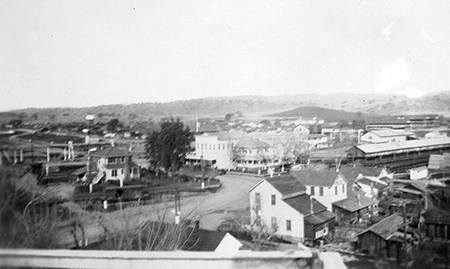
Driving past Merced Falls on the way to Lake McClure doesn’t usually inspire thoughts of a bustling mini-metropolis with its own movie theater.
But a new exhibit opening at the Merced County Courthouse Museum highlights a slice of Merced County’s past as an industrial center and showcases a new collaboration between the museum and the UC Merced Library and a graduate student.
Between 1912 and 1943, Yosemite Lumber Company (YLC) operated a booming lumber mill in Merced Falls, with 1,000 or so workers. The town had company housing for workers and executives as well as non-company residents, a local store and a movie house that showed talkies.
“Most people would never know all this existed out there,” said museum Treasurer Grey Roberts, a UC Merced Board of Trustees member. Roberts’ family is from Merced Falls, and he has contributed a large number of old and beautifully preserved photos from the turn of the 20th century, when his family owned and ran a boarding house and a stage-coach stop in Merced Falls.
In the late 1800s, there were wool and flour mills, but they burned down in the mid-1890s and it wasn’t until YLC decided to leverage the Yosemite Valley Railroad to haul the massive trees workers harvested near El Portal down to Merced Falls that a new mill was built.
These days, all people can see are the remnants of the old railroad line along the Merced River on the way in to Yosemite, or the ruins of a few buildings in Merced Falls. And many people think the only industry here — ever — is agriculture.
But the new exhibit, which opens today (March 8) and runs through June 10 at the museum in downtown Merced, brings to life the story of the YLC, the thriving little industrial town of Merced Falls and the railroad, and what life was like in Merced Falls from the late 1800s until the lumber mill and the railroad closed.

Emily Lin, the head of Digital Curation and Scholarship for the UC Merced Library, said the library has provided guidance on digitization and metadata creation, and it will preserve and host the collection in the UC libraries’ digital asset management system, enabling free public access through Calisphere.
The exhibit will also feature an interactive map created by Interdisciplinary Humanities graduate student Rocco Bowman of Sonora. The museum was fortunate enough to get the original Sanborn maps of Merced Falls — maps of each building created for fire insurance companies. Bowman, with support from UC Merced’s Spatial Analysis and Research Center, has digitized the maps and superimposed them onto high-resolution satellite photos to create a searchable interactive map that will let users explore the Merced Falls of the early 1900s. The museum hired Bowman to help with the project, and he said he has been uploading the museum’s digitized photos and preparing the metadata for each, as well as creating the new interactive portion of the display. He hopes to make the interactive map freely available on ArcGIS.com.
“Working with the museum is part of what I really like to do,” Bowman said. “I like getting out into the community and meeting people and working on projects that are separate from my own research.”
Bowman is only one of the many people who have contributed to the project.
Museum Director Sarah Lim said the museum appreciates all the resources that have brought the exhibit together, from Professor David Torres-Rouff ’s students who, more than a year ago, began researching different aspects of Merced Falls for their class on how to conduct academic research, to the rare finds such as the YLC company physician’s memoir and people’s family documents and personal artifacts.
“Grey’s pictures and his postcard collection and family connections are invaluable. Jack Burgess basically guided us through the whole history of the YLC and the railroad,” she said. “People have contributed family histories, oral histories, letters, books, pictures — we are so lucky. It’s not often that a museum has access to the quantity and quality of the materials we’re presenting.”
Lorena Anderson

Senior Writer and Public Information Representative
Office: (209) 228-4406
Mobile: (209) 201-6255






